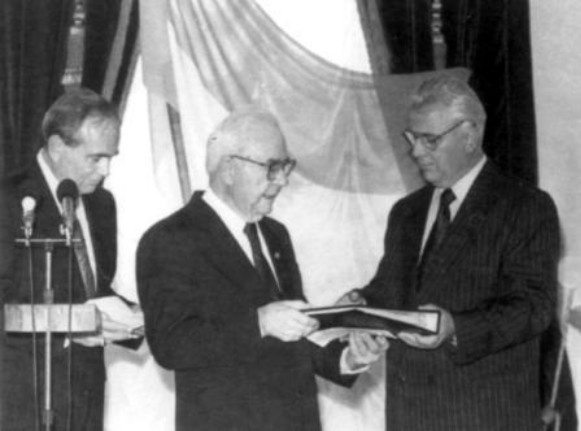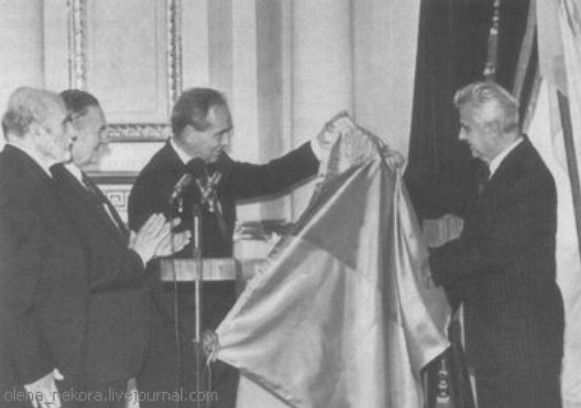Government-in-exile of the Ukrainian National Republic
Government-in-exile of the Ukrainian National Republic [Уряд Української Народної Республіки в екзилі; Uriad Ukrainskoi Narodnoi Respubliky v ekzyli]. The government institutions of the Ukrainian National Republic were evacuated first partly (end of 1919) and then totally (1920) from Ukraine as Bolshevik troops occupied the country. Most of the institutions were relocated in Tarnów, Poland, and a few in Częstochowa. Later they were moved to Warsaw, Paris, and Prague.
The government-in-exile of the Ukrainian National Republic was based on the Law on the Temporary Supreme Authority and the Legislative System of the Ukrainian National Republic and the Law on the State People's Council, which were adopted by the Directory of the Ukrainian National Republic in Ukraine on 12 November 1920. These acts, which were based on the resolutions of the Labor Congress, transferred legislative powers and ultimate authority over the government to the State People's Council. But until this council would be convened, its functions were assigned to the Council of National Ministers of the Ukrainian National Republic, while the Directory, or more precisely its head, was empowered to act as the supreme state authority: to approve laws, treaties, appointments, foreign representation, etc. If the Directory head became unable to carry out these responsibilities, they would be transferred to a special college, and if this college could not be convened, they would be assumed by the head of the Council of National Ministers.
Apart from the shortlived Council of the Republic in Tarnów, which consisted of representatives of political parties, professional associations, and cultural organizations, there was no legislative body among the state institutions in exile. It was only in 1947 that the Ukrainian National Council was formed to act as a parliament in exile, with authority to elect succeeding governments.
Until 25 May 1926 the head of the Directory of the Ukrainian National Republic, and hence of the state, was Symon Petliura. After Petliura's death this office was assumed by Andrii Livytsky, and in 1939–40 by Viacheslav Prokopovych. The Council of National Ministers of the Ukrainian National Republic was headed in exile by Livytsky (1920–1 and 1922–6), Pylyp Pylypchuk (1921–2), Prokopovych (1926–39), Oleksander Shulhyn (1939–40), and Kost K. Pankivsky (1945–8). The government-in-exile suspended activities during the Second World War, but Livytsky, as head of the Directory, signed various petitions to the German government. After the war the composition of the government changed as activists of several Western Ukrainian political parties and of civic organizations from Soviet Ukraine joined the government.
The government-in-exile never established itself as the sole political center for Ukrainians in the diaspora: it was opposed both by parties active in the Ukrainian National Republic during the struggle for independence (1917–20) and in interwar Western Ukraine. Often, the government was treated as just another party, whose members were labeled ‘uenerivtsi.’ The government's strongest support came from the followers of the Ukrainian Democratic Radical party (see Ukrainian Party of Socialists-Federalists), which provided most of the government officials. The Ukrainian Social Democratic Workers' party did not join the government, but recognized its legitimacy. In contrast, the Ukrainian Party of Socialist Revolutionaries, led by Mykyta Shapoval, strongly opposed the government, as did the Hetmanite Ukrainian Union of Agrarians-Statists and the Organization of Ukrainian Nationalists. The attitude of political circles from Galicia, particularly of the Ukrainian National Democratic Alliance, changed from rejection (because of the Treaty of Warsaw), to indifference, and finally to co-operation on specific political and civic issues.
The government acted through a number of ministries and institutions. External affairs—the sphere of most intensive activity—were overseen by Andrii Nikovsky, and then by Oleksander Shulhyn (until 1946). At first the government maintained diplomatic representatives of the Ukrainian National Republic in a number of countries, among them Kost Matsiievych in Romania, Andrii Livytsky in Poland, Maksym Slavinsky in Czechoslovakia, Roman Smal-Stotsky in Germany, Mykola Vasylko in Switzerland, Volodymyr Mursky in Turkey, and Shulhyn in France. Except for France, all the missions in those countries were abolished at the beginning of the 1920s. As head of the mission in Paris and later as minister for foreign affairs, Shulhyn maintained contact with the League of Nations, where he protested against the Bolshevik occupation of Ukraine, Soviet diplomatic initiatives, and the Stalinist terror and the Famine-Genocide of 1932–3 in Ukraine. The government-in-exile conducted some of its activities in foreign affairs through the Ukrainian Association for the League of Nations and, from 1933 to 1939, through a permanent secretariat in Geneva, run by Mykola Livytsky. It was also active in organizing the Promethean movement among émigrés from countries occupied by Soviet Russia.
The government-in-exile devoted special attention to military organs, which were responsible for training military personnel, organizing former soldiers, and maintaining clandestine contacts with supporters in Soviet Ukraine. These were overseen by Volodymyr Salsky, the minister of military affairs (to 1940), and by Generals Oleksander Udovychenko, Marko Bezruchko, Vsevolod Petriv, and Mykhailo Omelianovych-Pavlenko. Some officers of the Army of the Ukrainian National Republic worked under special contract for the Polish army and received Polish military training. To promote the military profession the government organized the Ukrainian Military History Society and published journals such as Tabor and Za derzhavnist’ as well as other literature.
In civic and cultural spheres the government-in-exile of the Ukrainian National Republic acted through various associations that supported it: the Union of Ukrainian Emigré Organizations in France, the Ukrainian Central Committee in Poland, the Public Relief Committee of Ukrainian Emigrants in Romania, the Ukrainian Alliance in Czechoslovakia, and others. Their work was co-ordinated by the Supreme Emigration Council headed by Oleksander Shulhyn. The Petliura Ukrainian Library (est 1926) in Paris maintained the archives of the Ukrainian National Republic. In 1938 the government founded the Ukrainian Mohylo-Mazepian Academy of Sciences. Thanks to the efforts of the government-in-exile, the Polish government set up the Ukrainian Scientific Institute in Warsaw. The weekly Tryzub, published in Paris from 1925 to 1940, was an unofficial publication of the government-in-exile. An important source of support for the government was the Brotherhood of Ukrainian Statism, founded in Ukraine during the struggle for independence (1917–20). Composed of civic leaders and intellectuals organized in a number of clandestine branches, members of the brotherhood met regularly to review the work of the government and to discuss changes in its composition and other matters.
After the Second World War the head of the Directory of the Ukrainian National Republic, Andrii Livytsky, reorganized the government-in-exile. Thus, in 1947 the Ukrainian National Council was set up as a pre-parliament of the state center in exile of the Ukrainain National Republic to continue the ideological and legal tradition of the government of the Ukrainiain National Republic. In 1980 arrangements were made to house the papers of the UNR government-in-exile in the National Archives of Canada (now Library and Archives Canada) until such time as Ukraine achieved independence. Following the 1991 Ukraine’s Declaration of Independence, President of the UNR government-in-exile Mykola Plaviuk formally handed over his powers to President of independent Ukraine Leonid Kravchuk. In 1996 the UNR archives were turned over to the Main Archival Administration of the Cabinet of Minsters of Ukraine.
BIBLIOGRAPHY
Iakovliv, A. ‘Osnovy konstytutsiï UNR,’ Tryzub, nos 114–15 (1928)
Shul’hyn, O. Derzhavnist’ chy haidamachchyna? (Paris 1931)
Shapoval, M. ‘Liakhomaniia,’ Nasha doba (1931)
Shul’hyn, O. Bez terytoriï: Ideolohiia ta chyn uriadu UNR na chuzhyni (Paris 1934)
Sal’s’kyi, V. ‘Shliakhy borot 'by,’ Tryzub, nos 174–7 (1940)
Livyts’kyi, M. DTs UNR v ekzyli mizh 1920 i 1940 rokamy (Munich–Philadelphia 1984)
Vynar, L.; Pazuniak, N. (eds). Derzhavnyi tsentr Ukraïns’koï narodn’noï respubliky v ekzyli: Statti i materiialy (Kyiv 1993)
Rudnyts’kyi, Ia. DTs UNR v ekzyli mizh 1941 i 1991/2 rokamy (Ottawa 1994)
Bruski, J. Petlurowcy: Centrum Panstwowe Ukrainskej Republiki Ludowej na wychodzstwie, 1919–1924 (Cracow 2000)
Arkadii Zhukovsky
[This article was updated in 2008.]


